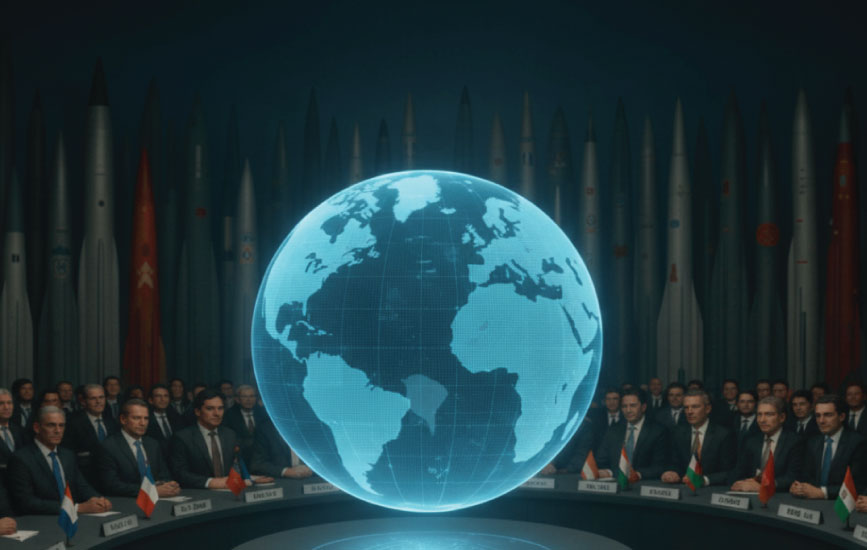The Intermediate-Range Nuclear Forces (INF) Treaty was signed between the United States and the Soviet Union in 1987; it lasted until the United States withdrew in 2019. It contributed to lowering the risk of an unexpected nuclear escalation in Europe and Asia during the Cold War by banning a whole range of conventional and nuclear weapons, including ground-launched ballistic and cruise missiles with ranges of 500–5,500 kilometers.
At the time, the Soviet Union and United States committed to reducing their nuclear arsenals, eliminating an entire category of nuclear weapons, and allowing thorough onsite inspections to ensure treaty compliance. During the Cold War, the INF Treaty served as a crucial stabilizing mechanism in the global nuclear order. Historically, the Strategic Arms Limitation Talks (SALT) of 1972 and 1979 were the first of several agreements between the US and the Soviet Union. As a result, both sides agreed to reduce their strategic weaponry, which included ballistic missile defenses, submarine-launched ballistic missiles, and intercontinental ballistic missiles.
In 1987, Ronald Reagan and Mikhail Gorbachev signed the INF Treaty. Additionally, they established inspection procedures to make sure both parties followed the agreement. Due to the treaty, 2,600 missiles were destroyed, marking a significant Cold War breakthrough. Despite decades of arms control, the US and Russia still field the largest nuclear forces. Although it is challenging to determine the exact extent of their stockpiles, the Stockholm International Peace Research Institute (SIPRI) estimates that the US possesses 5,328 warheads, while Russia has 5,580.
In August 2025, Russia declared it would no longer fulfil its commitments under the INF Treaty, citing increasing threats from the United States and other Western nations. When the US withdrew from the INF Treaty in 2019 because of Russian noncompliance with treaty limitations, Moscow stated that it would not use such weapons as long as Washington did not. This may have served as an effective ruse, but it served a purpose.
Questions are increasing about the utility of nuclear proliferation, the threat of arms racing, and the future of nuclear deterrence following the decision of Russia to fully abrogate the INF Treaty. The collapse of the INF Treaty represents a significant shift in the trajectory of international arms control.
The situation took a more dramatic turn as President Donald Trump announced that the US would move two of its nuclear-armed submarines closer to Russia in reaction to the “inflammatory statements” issued by former Russian President Dmitry Medvedev. This action highlights the challenge that arises when arms control breaks down—the potential for misunderstandings and overreactions increase.
Among nuclear-armed states, communication, predictability, and a certain measure of self-control are essential elements of nuclear deterrence. They were shaped by the INF Treaty, which placed verifiable limitations on missile sites. With the failure of the INF Treaty, useful tools were removed.
The future deployment of intermediate-range systems in regions that were shielded from them may prove an urgent strategic issue. Once at the epicenter of Cold War nuclear worries, Europe may have to host such weapons once more, but with improved accuracy, shorter travel times, and, perhaps, lower yields.
Deterrence dynamics in the Asia-Pacific are more difficult, especially between the US, China, and Russia, after the INF Treaty. The great powers are now accelerating nuclear modernization, while non-nuclear states are reconsidering their nonproliferation commitments. A replay of the Cold War–era European missile crisis has emerged with the collapse of the treaty.
Now, both Russia and the US are free to use and develop short-, medium-, and intermediate-range missiles without any official restraints. One more issue concerns the intentions of other governments, who may be influenced by the deterioration of controls on nuclear systems. States that did not previously possess nuclear weapons may choose to acquire them. Modern arms racing may be fast, less predictable, and more destabilizing due to technological advancements, such as autonomous delivery systems, hypersonic weapons, and AI-assisted targeting.
There are limited prospects for cooperative tools to mitigate these risks of escalation between the US and Russia. The two largest nuclear powers have a special duty to control and limit the scope of their competition.
Measures that encourage openness, trust, and communication between nuclear and non-nuclear governments will be crucial. In the absence of a global treaty, regional security accords, tailored to today’s security challenges, can effectively restrict risky deployments and restrain great powers from further modernizing their nuclear arsenals.
Nations in the Asia-Pacific can, for example, agree to mutual missile deployment restrictions similar to those in the INF Treaty’s verification procedures, which include regular inspections and satellite monitoring by mutual compliance. This would prevent insecure military build-ups in the region and reduce mistrust between states. Whatever course nations take, the importance of preventing escalation to nuclear use is foremost.
Nazia Sheikh is a Research Officer at the Centre for International Strategic Studies, AJK. Views expressed in this article are the author’s own.



